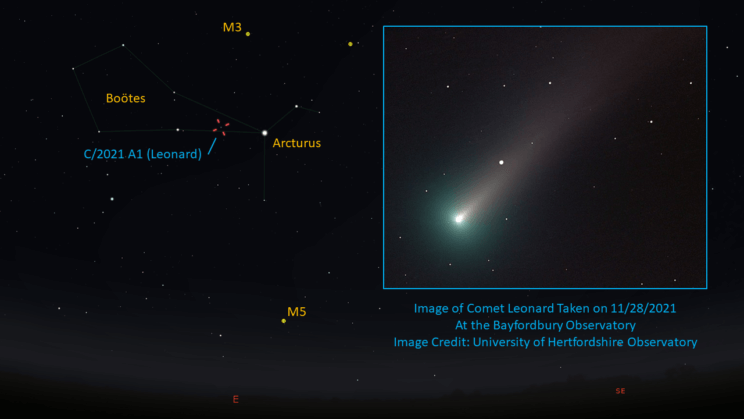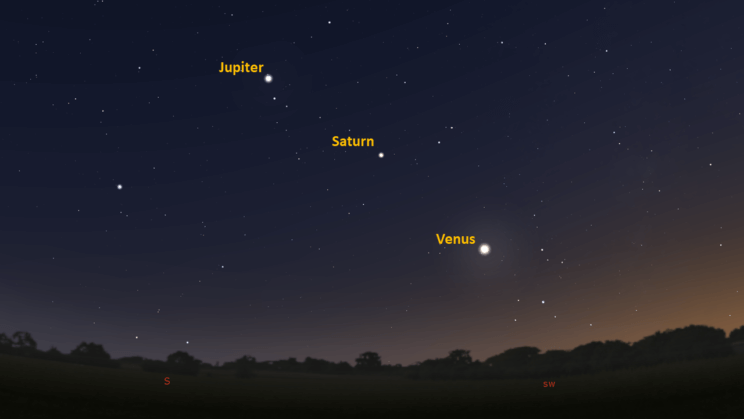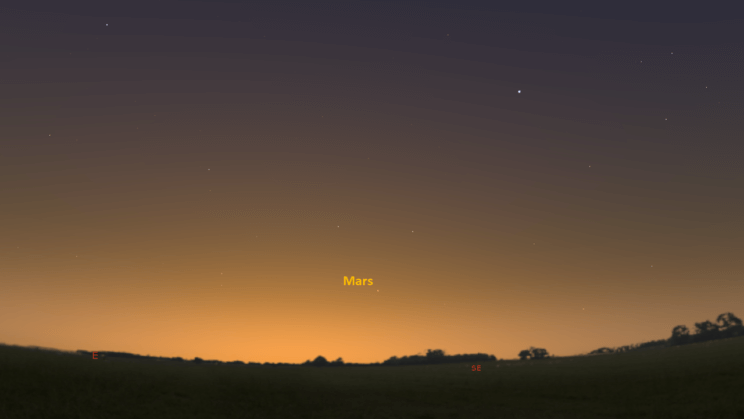This is the Saint Louis Science Center’s NIGHT SKY UPDATE for the week of Friday, December 3, 2021.
Information updated weekly or as needed.
Times given as local St. Louis time which is Central Standard Time (CST). For definitions of terminology used in the night sky update, click the highlighted text. If relying on times posted in Universal Time (UT), St. louis is -6 hours when CST.
Public Telescope Viewings
With the changing recommendations from the CDC regarding COVID-19, conversations regarding the return of star parties at the Saint Louis Science Center have begun. We are close to bringing back our public telescope viewings, but a few details still need to be worked out. We will post future updates as we learn more about when we can bring back telescope viewings.
Observing Highlight of the Week

Position of C/2021 A1 (Leonard) in Boötes of on December 6, 2021 at 5 am. Map created using Stellarium. Comet image credit: University of Hertfordshire Observatory
The highlight for this week is a comet called C/2021 A1 (Leonard). C/2021 A1 (Leonard) was discovered on Jan. 3, 2021, by astronomer G. J. Leonard at the Mount Lemmon Observatory. Often, comets are named after the person who discovered them, which is why many articles covering this comet will refer to it as Comet Leonard. C/2021 A1 (Leonard) is a long period comet that has been moving sunward for the last 35,000 years from an aphelion distance of 3500 AU (325.5 billion miles). When at perihelion, C/2021 A1 (Leonard) will be about 0.6151 AU from the Sun. C/2021 A1’s orbit will be hyperbolic after this, which means it will likely be ejected from the solar system. C/2021 A1 (Leonard) will be closest to Earth on Dec. 12, 2021, at 0.233 AU, which is about 21.7 million miles away.
This week, our best chance to see C/2021 A1 (Leonard) occurs from Dec. 3-9. Conveniently, the comet is about to pass through the constellation Boötes, passing by several bright objects that are easy to find. Around 5:00 a.m. on Dec. 4, the comet will be about 3.5° east of the globular star cluster Messier 3. From Dec. 5-7, C/2021 A1 (Leonard) will be near the star Arcturus. This bright star is easily identified and will serve as a guide to find the comet for several days. Morning views will begin to wane after Dec. 10. Eventually, C/2021 A1 (Leonard) will appear lower to the horizon, becoming lost in the Sun’s glare. C/2021 A1 (Leonard) will become visible in the southwest after sunset starting around Dec. 15. Once visible after sunset, C/2021 A1 (Leonard) will not be seen higher than 10° above the horizon from St. Louis. Trees and buildings will complicate things. A useful guide to finding the comet after Dec. 15 is Venus. From Dec. 16-20, C/2021 A1 (Leonard) will approach and pass by Venus in the sky. The comet will be closest to Venus on Dec. 18.
C/2021 A1 (Leonard) is expected to reach fourth magnitude. As of this writing, the comet has been reported to be around 7.5 magnitude. This week the comet is predicted to brighten from roughly sixth magnitude to about 4.5 magnitude. Due to city lights, a telescope or moderate binoculars will be needed to spot the comet.
I was able to see comet C/2021 A1 (Leonard) through a variety of binoculars. I used 6x30mm, 10x50mm and 15x70mm on the morning of Dec. 3 to spot the comet. Using 6×30 binoculars, the comet swam in and out of view. C/2021 A1 (Leonard) is still to faint to be easily seen in small binoculars. Using 10×50 binoculars, I was able to clearly identify the comet using averted vision. Seen through 15×70 binoculars, the comet was easy to see as a faint patch of light. To my eye the fuzzy patch of light seen seemed to be slightly elongated, but I was unable to resolve a tail. I estimate that C/2021 A1 (Leonard) was between 7.5 and 7.0 magnitude on Dec. 3. Weather dependent, the comet should become easier to see as we head into the week. To find the comet, you will need a map of its path or a desktop planetarium software. I use something called Stellarium, which is a free planetarium software that can be used on all platforms. If you plan to use Stellarium, you will need to update its catalog of visible comets. There are several tutorials online that can help with this. If you do not want to put another software on your computer, Sky and Telescope has a few articles about Comet Leonard I would recommend as they go deeper into what we may see with C/2021 A1 (Leonard) I recommend this article https://skyandtelescope.org/astronomy-news/how-bright-will-comet-leonard-get/ from Bob King.
Another excellent resource for comet information and maps is https://cometchasing.skyhound.com/. This observing website is a great way to stay up to date with comets that can be seen.
The Sun and Moon

The Moon as seen from the International Space Station, on July 31, 2011.
Credit: NASA
Sunrise is at 7:02 a.m. on Friday, December 3 and sunset is at 4:39 p.m. providing us with roughly 9.5 hours of daylight. Even after sunset, the light from the Sun will dimly illuminate our sky for roughly 1 hour and 30 minutes. This period is called twilight, which ends around 6:14 p.m. this week. For those with a sundial, local noon occurs around 11:50 a.m. this week.
| Day | Sunrise | Sunset |
|---|---|---|
| 2021-12-03 | 7:02 a.m. | 4:39 p.m. |
| 2021-12-04 | 7:03 a.m. | 4:39 p.m. |
| 2021-12-05 | 7:04 a.m. | 4:39 p.m. |
| 2021-12-06 | 7:04 a.m. | 4:39 p.m. |
| 2021-12-07 | 7:05 a.m. | 4:39 p.m. |
| 2021-12-08 | 7:06 a.m. | 4:39 p.m. |
| 2021-12-09 | 7:07 a.m. | 4:39 p.m. |
| 2021-12-10 | 7:08 a.m. | 4:39 p.m. |
| 2021-12-11 | 7:09 a.m. | 4:40 p.m. |
Moon
Moonrise for Friday, December 3 occurs at 6:11 a.m. and moonset will occur at 4:11 p.m. On Friday, December 3 the Moon will be close enough to new moon that we will not see it. New moon occurs on December 4, 2021, at 1:43 a.m.
International Space Station (ISS) Observing

Visible passes of ISS from St. Louis for the week of December 3 occur during evening hours. The best passes this week occur on the evenings of December 5, 7 and 8. Use the table below for information about this and other visible passes this week.
Catch ISS from St. Louis starting Friday, December 3
| Date | Starts | Max. altitude | Ends | |||||||
|---|---|---|---|---|---|---|---|---|---|---|
| Time | Alt. | Az. | Time | Alt. | Az. | Time | Alt. | Az. | ||
| 04 Dec | -1.8 | 17:12:55 | 10 | NNW | 17:15:02 | 15 | NNE | 17:17:09 | 10 | ENE |
| 04 Dec | -1.6 | 18:48:57 | 10 | NW | 18:50:17 | 22 | NW | 18:50:17 | 22 | NW |
| 05 Dec | -3.4 | 18:01:50 | 10 | NW | 18:05:06 | 44 | NE | 18:05:33 | 41 | ENE |
| 06 Dec | -2.7 | 17:14:46 | 10 | NNW | 17:17:47 | 28 | NNE | 17:20:47 | 10 | E |
| 06 Dec | -1.9 | 18:51:32 | 10 | WNW | 18:54:08 | 31 | WSW | 18:54:08 | 31 | WSW |
| 07 Dec | -3.2 | 18:04:07 | 10 | WNW | 18:07:28 | 59 | SW | 18:10:05 | 15 | SE |
| 08 Dec | -3.8 | 17:16:51 | 10 | NW | 17:20:15 | 77 | NE | 17:23:37 | 10 | SE |
| 09 Dec | -0.8 | 18:07:08 | 10 | W | 18:09:33 | 18 | SW | 18:11:57 | 10 | S |
| 10 Dec | -1.6 | 17:19:23 | 10 | WNW | 17:22:26 | 31 | SW | 17:25:29 | 10 | SSE |
Magnitude (Mag): The Measure of brightness for a celestial object. The lower the value is, the brighter the object will be.
Altitude (Alt): The angle of a celestial object measured upwards from the observer’s horizon.
Azimuth (Az): The direction of a celestial object, measured clockwise from an observer’s location with north being 0°, east being 90°, south being 180° and west being 270°.
For information about ISS flyovers and other visible satellites, visit www.heavens-above.com
Detailed information regarding all unmanned exploration of our universe, missions past, present, and planned, can be found at Jet Propulsion Laboratories:
The Visible Planets

Looking South, at 5:30 p.m. December 3, 2021. Credit: Stellarium, EG

Looking east, at 6:30 am, December 4, 2021. Credit: Stellarium, EG
This week, four naked eye planets are visible. Venus can be found in the south southwest after sunset. Jupiter and Saturn can be found in the south after sunset. Mars is still tough to see but it is steadily climbing out of the Sun’s glare in the east before sunrise.
Venus
Venus is well into another evening apparition. It will be visible in the southwest as the sun sets. Venus will set at 7:21 p.m. Venus is on its way back towards the Sun’s glare as it approaches inferior conjunction on January 8, 2022. Venus is now bright enough to be seen naked eye during the day. If you have never attempted to spot Venus in the day, near sunset is the time to begin. As always, use precaution when trying to find something in the day as the Sun will be in the sky. Remember, never look directly at the Sun.
Mars
A new apparition for Mars has begun. Mars is becoming visible about 30 minutes before sunrise. Look for the Red Planet 9° above the eastern horizon around 6:30 a.m. Mars will continue to climb out of the Sun’s glare as we see the end of 2021. Mars reaches opposition next year on December 7, 2022.
Jupiter
Jupiter has passed opposition and as such will be visible after sunset. Look for Jupiter in the south as it starts to darken outside. Jupiter sets at 10:15 p.m. and will set about 30 minutes earlier each week. Jupiter reaches superior conjunction on March 5, 2022. This means we can count on seeing Jupiter in the southern skies for the rest of this year and well into 2022.
Saturn
Saturn is past opposition which means it will be visible about 20 minutes after sunset. Right now, it can be found in the south after sunset, but as we continue through the year, Saturn will set about 30 minutes earlier each night. Saturn sets at 8:52 p.m. Saturn will reach superior conjunction on February 4, 2022.
James S. McDonnell Planetarium
Night Sky Update: December 3 – December 11, 2021






